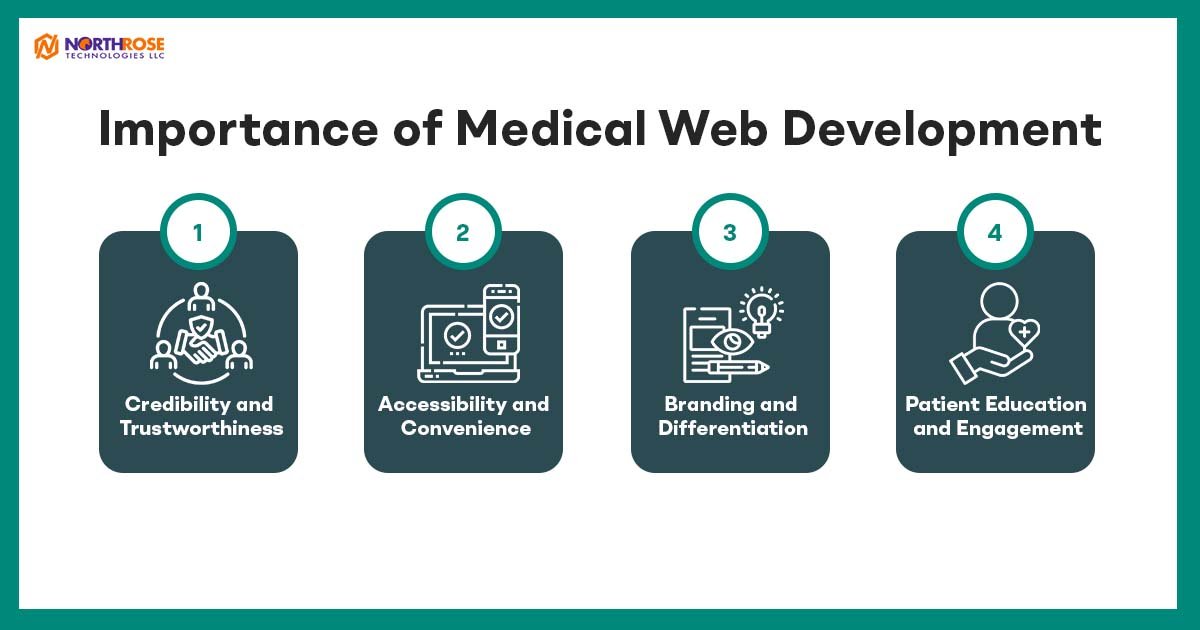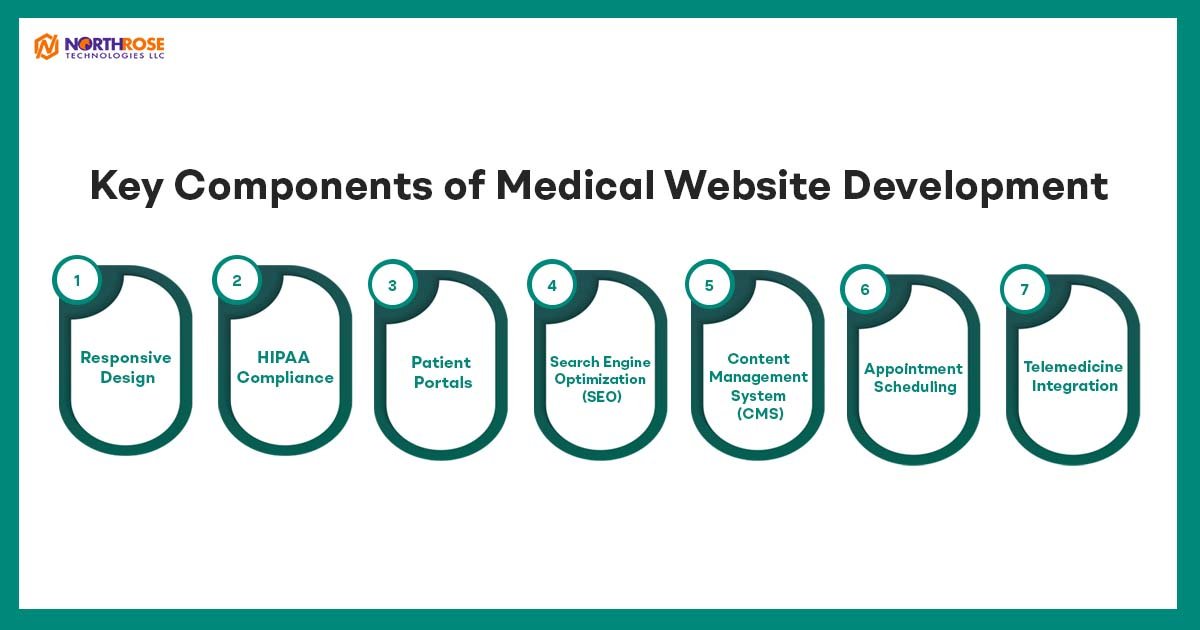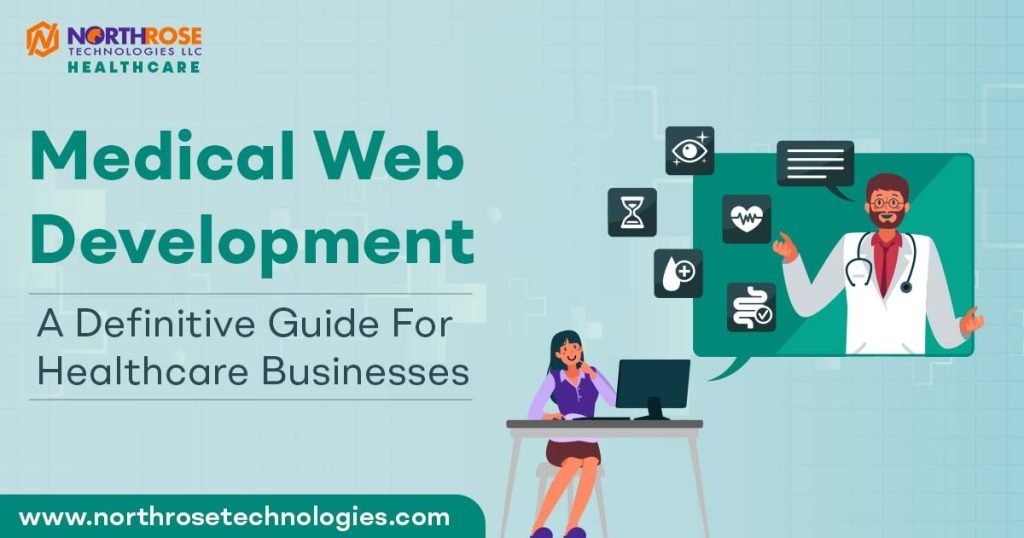Organizations in all sectors—including healthcare—must have a strong online presence.
Given that the majority of patients now look online for healthcare information and services, medical web development is now crucial for healthcare organizations looking to successfully connect with and engage their target market.
It is essential to have a well-designed and functional website if you are a hospital, clinic, or solo practitioner to draw patients, offer helpful information, and provide high-quality care.
Importance of Medical Web Development
For those looking for healthcare services, the internet is their main information source. Websites are used by patients to locate medical professionals, find information about their services, read reviews, and even make online appointments.
Therefore, for healthcare organizations to establish credibility, draw clients, and maintain their position as industry leaders, they need to have an appealing and informative website.

1) Credibility and Trustworthiness
Patients feel more confident when they visit a well-designed website, which also presents the healthcare provider as dependable and trustworthy. Patients may have concerns about the standard of care they will receive if a website is outdated or poorly built.
2) Accessibility and Convenience
Patients can quickly access information and services anytime, anyplace with a user-friendly website that works across multiple devices. Patients’ entire experience and convenience are improved by features like telemedicine choices and online appointment scheduling.
3) Branding and Differentiation
Healthcare organizations can highlight their distinct brand identity, beliefs, and services with a well-designed website. It allows them to stand out from competitors and leave a lasting impression on prospective patients.
4) Patient Education and Engagement
An informative website serves as a valuable resource for patients, providing them with access to educational content, preventive care information, and resources for managing their health. Engaging elements such as blogs, videos, and interactive tools can enhance patient engagement and empower them to take control of their health.
Key Components of Medical Website Development
Building an effective medical website requires careful planning, attention to detail, and collaboration between healthcare professionals and web developers.
Several key components contribute to the success of a medical website, including:

1) Responsive Design
It is imperative to have a flexible website design that adjusts to various screen sizes due to the growing popularity of mobile devices. By ensuring the best possible viewing and interaction experience on desktops, laptops, tablets, and smartphones, responsive design raises user happiness and engagement levels.
2) HIPAA Compliance
To protect patient privacy and security, healthcare websites need to abide by the Health Insurance Portability and Accountability Act (HIPAA). Strong security measures, encryption techniques, and access controls must be put in place to safeguard sensitive data and maintain HIPAA compliance.
3) Patient Portals
Through patient portals, patients can securely contact healthcare providers and access their lab results, medical information, and appointment schedules. Including a patient portal on the website improves patient participation, expedites administrative processes, and strengthens communication between patients and providers.
4) Search Engine Optimization (SEO)
To improve visibility and draw in organic traffic, search engine optimization is crucial for the website. Healthcare websites may rank higher in search engine results and attract more potential patients by putting SEO best practices, such as keyword research, metadata optimization, and content creation, into effect.
5) Content Management System (CMS)
Healthcare providers can effectively maintain and update the content of their websites with the help of a strong content management system (CMS). Well-known content management systems, including WordPress, provide healthcare practices with customizable themes, intuitive user interfaces, and plugins.
6) Appointment Scheduling
Patients can easily schedule appointments online, eliminating the need for calls or emails, by integrating an online appointment scheduling system into the website. Efficiency is increased and the patient experience is improved with features like automated confirmations, real-time availability, and appointment reminders.
7) Telemedicine Integration
By integrating telemedicine, healthcare professionals can provide patients with virtual visits and remote consultations, increasing access to care and enhancing patient outcomes. Appointment scheduling tools, payment processing capabilities, and secure video conferencing platforms are necessary for integrating telemedicine features into the website.
Best Practices for Medical Website Development
Developing a successful medical website requires adherence to best practices and industry standards to ensure effectiveness, security, and compliance.
1) Prioritize User Experience (UX)
Prioritize developing a smooth and user-friendly interface that meets patient needs and makes it simple to navigate and get information. To improve usability and engagement, include calls-to-action (CTAs) that are explicit, a logical site structure, and intuitive design components.
2) Maintain Visual Consistency
Maintain visual consistency throughout the website by adhering to brand guidelines. This means following cohesive color schemes, typography, and imagery. Consistent branding reinforces brand identity, establishes credibility, and enhances the overall aesthetic appeal of the website.
3) Ensure Accessibility Compliance
To guarantee that people with disabilities have equal access to information and services, make sure the website conforms with web accessibility standards (such as WCAG). Enhancing accessibility and improving the user experience for all visitors can be achieved by including features like keyboard navigation, semantic HTML, and alt text for images.
4) Optimize Site Performance
Reduce page load times, optimize multimedia and picture content, and use caching and compression strategies to improve the performance of your website. Websites with a quick load time increase user satisfaction, lower bounce rates, and boost search engine results.
5) Regularly Update Content
Regularly update website content to keep it fresh, relevant, and engaging for visitors. Publishing informative blog posts, articles, and multimedia content demonstrates expertise, enhances SEO, and encourages repeat visits from patients seeking valuable information.
6) Monitor Website Analytics
Monitor website analytics regularly to track key performance indicators (KPIs), such as traffic, engagement, and conversion rates. Analyzing user behavior, demographics, and conversion funnels provides valuable insights for optimizing website performance and achieving business objectives.
In conclusion, medical web development is essential to helping healthcare organizations draw patients, build a solid online presence, and provide high-quality service. Healthcare organizations can develop websites that improve patient engagement, boost business growth, and follow best practices by realizing the significance of medical web development.
This is where North Rose Technologies comes in, by helping you design and develop a strong online presence.

